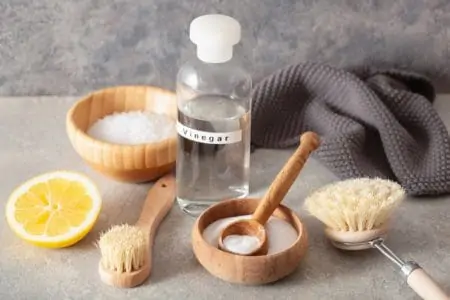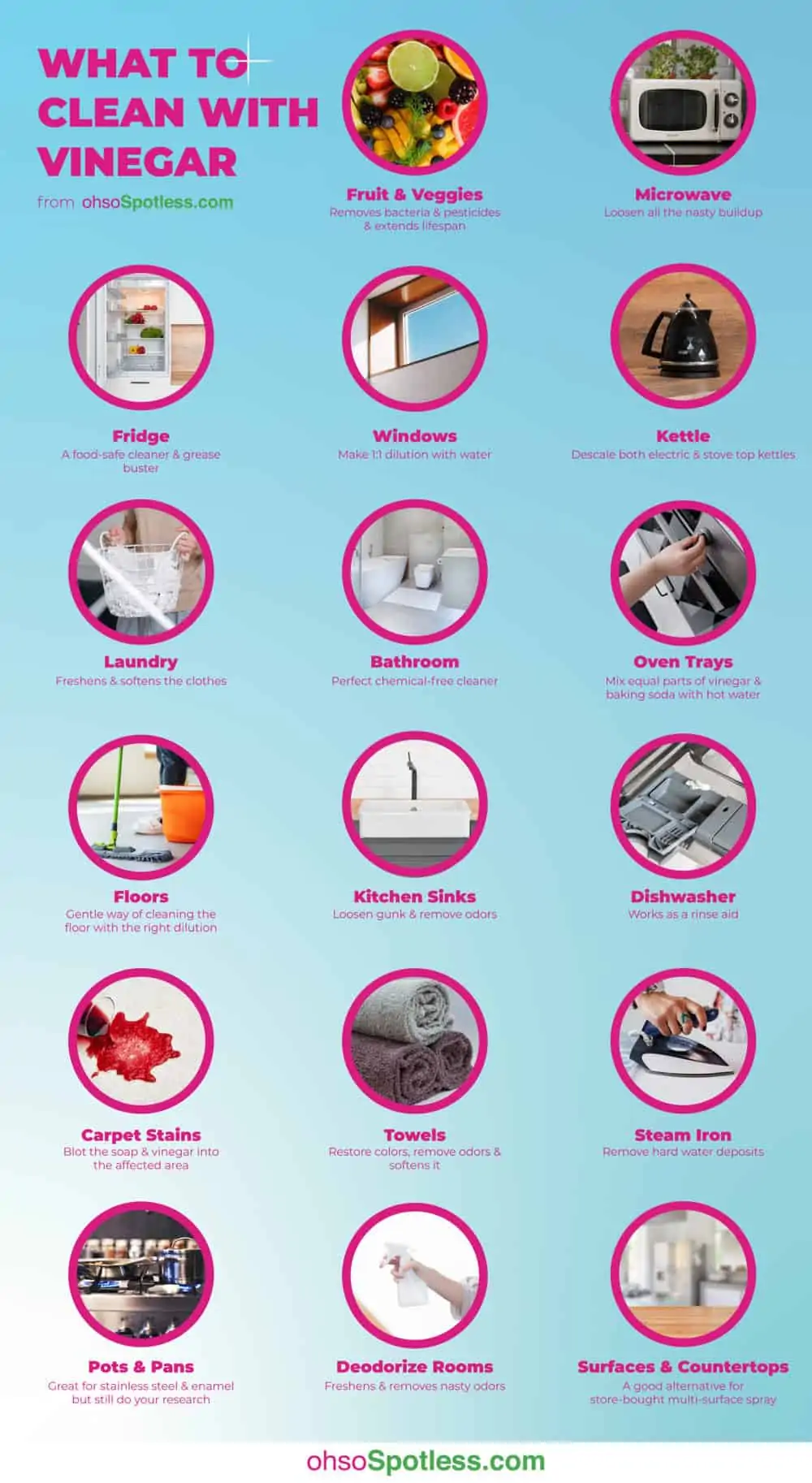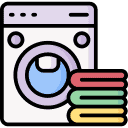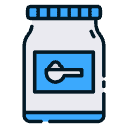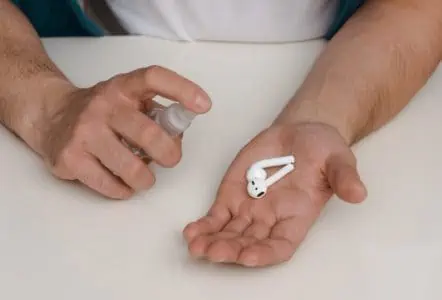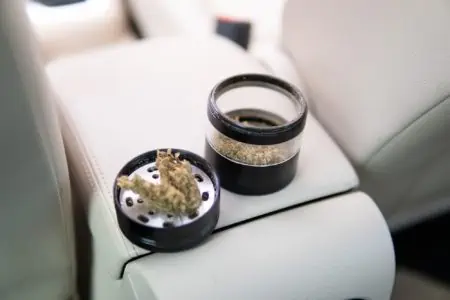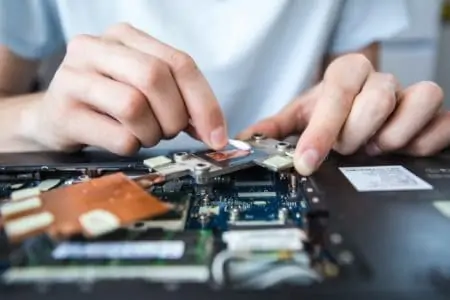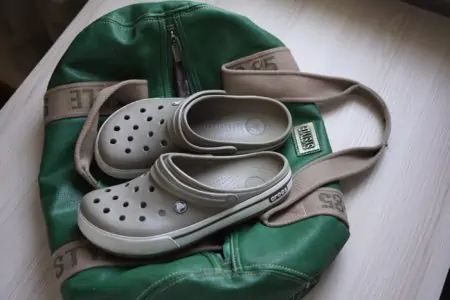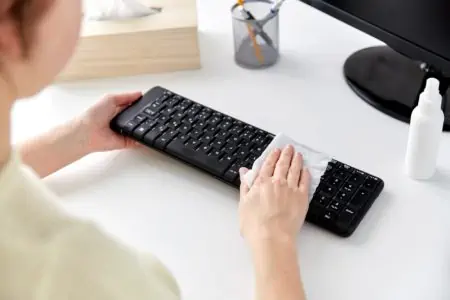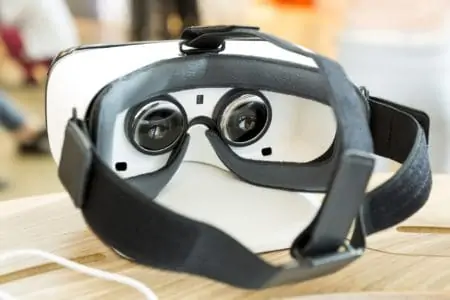The other day, somebody asked me, “What cleaning products do I need in my new house?” The first thing I told her was: distilled white vinegar.
Keeping a big tub of distilled white vinegar in your cupboard is a must-have for homeowners. It can clean a range of things, including stains, counters, and even remove odors. If you’re looking to go eco-friendly and cut down on having dozens of cleaning products in your cupboard, this is the article for you.
Keep reading to learn how to clean with vinegar, what to clean with vinegar and what not to clean with vinegar.
Key Takeaways
- Vinegar is a versatile cleaner that can replace many store-bought products.
- Use a 1:1 solution of water and distilled white vinegar for most cleaning tasks.
- Vinegar can clean various surfaces, such as windows, countertops, and appliances.
- However, avoid using vinegar on wood, stone, and some appliances, as it may cause damage.
How to Clean With Vinegar
If you’re new to the vinegar realm of cleaning, it can seem a little daunting to clean with vinegar. Isn’t vinegar something we eat? Well, yes, but there is also vinegar that’s acidic enough to clean your home, and that’s what we want to focus on.
Is There a Difference Between Cleaning Vinegar and Distilled Vinegar?
Yes, but you can definitely use regular distilled white vinegar for cleaning. That’s what we use in our house, and it works wonders. However, there is a difference, albeit small.
Distilled white vinegar is made up of 5% acetic acid and 95% water (1). Cleaning vinegar is made up of 6% acetic acid and 94% water. While that seems like a tiny difference, that 1% makes it 20% stronger than regular distilled white vinegar.
If you want to go to town when cleaning with vinegar, you can use the 6% cleaning vinegar. However, you can also use regular distilled white vinegar.
There are lots of variations of vinegar, so make sure you’re not cleaning with:
- Industrial vinegar which often contains up to 20% acetic acid.
- Balsamic vinegar.
- White wine vinegar.
- Red wine vinegar.
- Rice vinegar.
- Malt vinegar.
Did You Know
You can clean with apple cider vinegar when that’s all that’s available, but it won’t be as effective as distilled or cleaning vinegar.
How Do You Make a Cleaning Solution With Vinegar?
It depends on what you’re cleaning, but here’s a basic recipe for a simple cleaning solution:
- One spray bottle.
- One cup of water.
- One cup of distilled white vinegar.
- 10-20 drops of essential oils (optional).
This is a great cleaner for countertops, room sprays, cleaning bathrooms, and many more surfaces.
Do You Have to Rinse After Cleaning With Vinegar?
Nope! You may think this because of the vinegar smell, but it’s really not noticeable, and it disperses quickly. In fact, if you add essential oils, this will override the vinegar, and you won’t be left with that sour smell.
What to Clean With Vinegar
Check out these 19 things you can clean with vinegar. We told you, it’s very versatile!
1. Fruit and Veg
Starting with one you probably didn’t know about: fruit and vegetables. Mix a 3:1 solution of water and vinegar and soak your fruit and vegetables in it for a few minutes. This works by removing bacteria and pesticides (2). In certain cases, it can lengthen the lifespan of your fruit and vegetables, so they don’t start rotting as quickly (3).
2. Deep Clean Microwave
This is a super satisfying vinegar cleaning hack. Mix a 1:4 solution of distilled white vinegar and water in a bowl. Put it in the microwave and turn it on for five minutes. Let it stand for three minutes after to cool slightly. Remove the bowl and wipe down the inside of the microwave with a clean cloth.
The acidic vinegar and steam work to loosen all the nasty buildup in your microwave so you can clean it much more quickly.
3. Deep Clean Fridge
Mix a 1:1 solution of vinegar and water using the recipe given above. Remove all food from the fridge and spray down the different shelves, corners, crevices, trays, and fridge walls.
Vinegar will work like a multi-surface spray to break down grease, grime, and other dirt. But it’s without the chemicals that store-bought cleaners contain, making it a food-safe option.
4. Clean Windows
Don’t waste money on store-bought cleaners when you can make your own homemade window cleaner vinegar. A simple 1:1 solution of water and vinegar works great for cleaning your windows.
Go The Extra Mile
Add ½ teaspoon of dish soap to this recipe if your windows are particularly dirty. This will strip grease and grime, removing that filmy surface.
5. Deep Clean Kettle
Pour a 1:1 solution of water and vinegar into your kettle. This works for both electric and stovetop kettles.
Boil, letting the white vinegar work naturally to descale and deep clean the inside. Rinse out the kettle, refill it and boil plain water a few times afterward to remove any trace of the vinegar. You don’t want your next cup of tea to have a vinegar flavor to it!
6. Laundry Day
Vinegar is incredible on laundry day. In fact, you can completely replace your fabric softener with white vinegar. Just add a few drops of essential oils to ensure that your clothes don’t smell of vinegar.
To use this method, simply add one cup of white vinegar to the rinse cycle of your laundry routine. It will remove detergent build-up, odors, stains, and it can even brighten your clothes. What’s not to love?
7. Clean the Bathroom
Ditch the store-bought, chemical-filled cleaner and replace it with white vinegar. Using straight vinegar or the recipe we supplied above, clean the countertops, sinks, toilets, and drains. Add essential oil to the mix for a beautiful fragrance in your bathroom.
8. Oven Trays
Do you ever look at your oven trays and think, “How do I even clean that?” Well, you guessed it, vinegar is the answer. Mix half a cup of vinegar and half a cup of baking soda with hot water in the sink. Don’t worry when it starts to bubble!
Add the oven trays to the water and soak them for 30 minutes on each side. Now you can scrub off the loosened residue easier than ever before.
9. Cleaning Floors
Half a cup of vinegar and half a gallon of warm water is all you need to deep clean your floors. Pour it into a bucket and mop your lovely floors. This will gently clean your floors without causing any damage. This is ideal for no-wax floors, too.
10. Deep Clean Sinks
This is one of our favorite ways to end the day. I know, fun, right? But it’s super satisfying and leaves the kitchen pristine for the next day.
Put the plug in and fill the sink with a little bit of distilled white vinegar. Spread it around with a cloth, scrubbing every inch of the sink. Then rinse away.
Afterward, pour the vinegar directly down the drain. It can loosen gunk and remove odors.
11. Dishwasher Rinse Aid
You can add some vinegar into the sink with your dish soap and water or add a few cups of vinegar to the bottom of your dishwasher before starting the cycle. This works as a rinse aid to ensure the hard water in your area doesn’t leave behind water stains on your dishes.
12. Carpet Stains
Mix one tablespoon of dish soap, one tablespoon of white vinegar, and two cups of warm water into a bowl. Use a sponge to blot the solution into the stain until it lifts. No more panicking the next time you notice a mark on the carpet.
13. Deep Clean Dishwasher
This is one of our favorite hacks ever. Deep cleaning your dishwasher by hand is a faff, time-consuming, and now, a thing of the past!
Instead, once a month, place one cup of vinegar into the dishwasher and turn your machine to the hottest setting. The vinegar will deep clean your dishwasher, breaking down grease and grime build-up, and clearing the drain.
14. Deep Clean Washing Machine
Don’t you love how vinegar can deep clean all the appliances in your home? Once a month, add one cup of vinegar into your machine’s drum or detergent dispenser. Turn the machine to the hottest setting or the drum clean setting and let the vinegar work its magic.
Warning
Always check with your manufacturer or user manual before this method, as some machines are made with rubber that is broken down by vinegar use.
15. Deep Clean Steam Iron
Pour a 1:1 solution of vinegar and water into your steam iron’s water reservoir. Turn the iron on, leave it in the upright position and let it run for five minutes.
Unplug it, let it cool, empty the reservoir and wipe the soleplate with a clean cloth. This method will deep clean the inside of your steam iron and remove hard water deposits with minimal effort from you.
16. Pots and Pans
Vinegar can break down grime, grease, and residue that your dish soap cannot get to. Boil some water and vinegar together and soak your pots and pans in it for up to one hour. Wash as normal and rinse well.
This is great for stainless steel and enamel but check with your manufacturer if vinegar is suitable for cleaning your specific cookware.
17. Deodorize Rooms
Do your rooms need freshening? Don’t want to use a store-bought room spray because of the random ingredients? Here’s a headache-free, eco-friendly option.
Mix a 1:1 solution of vinegar and water in a spray bottle, adding essential oils if you’d like. Spray it all over the room. You can even target carpets, rugs, furniture, and other items that cling to odors.
18. Wash Towels
Replace your laundry detergent completely with this tip. Simply put your towels in the washing machine with half a cup of white vinegar. Set the machine to the highest temperature the towels allow and start the machine.
The vinegar will work to remove detergent residue that’s built up on your towels, as well as other dirt and grime. It can also restore colors, remove odors and make the towels soft and fluffy again.
19. Surfaces and Countertops
Last but definitely not least, use vinegar for cleaning your countertops and surfaces. Let this replace a store-bought multi-surface spray. Using our recommended recipe from above, spray your tabletops, countertops, wooden furniture, and other surfaces with the solution. Wipe well with a clean cloth.
What Can You Not Clean With Vinegar?
While vinegar is definitely incredible, and we love using it in our home, it’s important to note the things that cannot be cleaned with vinegar.
1. Some Irons
While some manufacturers allow vinegar for deep-cleaning their irons, others don’t. The acid in the vinegar can break down some of the parts inside the iron and cause damage. Always check with your manufacturer before using vinegar to clean your iron.
2. Certain Stains
While vinegar can remove a range of stains, there are some stains it just doesn’t work on. This includes:
- Blood.
- Ink.
- Ice cream.
- Grass stains.
Many stains require an enzyme cleaner — or a green laundry detergent — to kick them to the curb. Don’t waste your time with vinegar if you know it won’t work.
3. Straight Vinegar for Wood Furniture
While you can definitely use vinegar for cleaning wood, always dilute it. Straight vinegar can ruin the finish on wooden furniture.
In fact, we would recommend using 5% vinegar over 6% in these instances. That’s what we use in our home, and our wooden furniture looks great!
4. Certain Appliances
While we recommend vinegar for cleaning kettles, washing machines, dishwashers, coffee machines, and other appliances, you must be careful. Many manufacturers use rubbers in these machines that can be broken down by vinegar.
Always check with your user manual before putting vinegar to the test here.
5. Digital Devices
Vinegar is a no-no when it comes to cleaning your phone, camera, tablet, and other electronic devices. Why? The vinegar can ruin the touchscreen devices and other special coatings on your devices.
Invest in a specialized electronic cleaner and a good microfiber cloth.
7. Egg Spills
If you drop an egg on the floor, you may think to grab your handy vinegar and water spray to clean it up, but that’s a bad idea. The vinegar can actually harden the egg, making it impossible to clean up.
8. Knives
When cleaning your dishes with vinegar, make sure you don’t put any vinegar on the knives. The vinegar can actually dull the knives’ edges. Always use the cleaning tips the manufacturer suggests, whether that’s dish soap or just water.
9. Granite and Marble
Definitely use vinegar to clean your surfaces, but not all surfaces. Never clean granite or marble with vinegar, as the acid can break down that beautiful glossy finish.
10. Stone Tiles
Natural stone and vinegar do not mix. While we suggest cleaning your bathroom with vinegar, don’t use it if you have any natural stone. The acid can cause damage, so make sure to use a stone-specific cleaner instead.
FAQs About Cleaning With Vinegar
Deep Clean With Vinegar
Now you know that you don’t need many random products from the store to deep clean your house. Vinegar works wonders!
Just be sure to check with your manufacturer before using it on appliances. Never use it on knives, digital devices, stone tiles, granite, marble, and a few more surfaces. Ensure to be safe, check the acidity levels on your vinegar, and never ingest cleaning vinegar.
